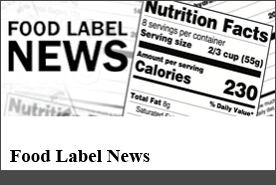
October 2017 - Volume 17, Number 10
Greetings!
Our deep dive into ingredient statement rules wraps up with a discussion about different forms of an ingredient and how each is treated on the ingredient list. It’s no surprise that it’s not as straightforward as food labelers might like. This and other topics are covered in the Food Label Community on LinkedIn, so if you have specific questions after reading the article, pose a question and we’ll all chime in. This month you can also read about the subtleties regarding enriched flour in Canada – a question from a reader.
In this issue:
- Ingredient Forms in the Ingredient Statement
- What's News in the Food Label Community
- Reader Q+A: Must Flour Always Be Enriched in Canada?
- Reader Favorites: Calorie Counting Confusion
Wishing you all the best this Fall,
![]()
Karen C. Duester, President, Food Consulting Company

Ingredient Forms in the Ingredient Statement
Diced? Dried? Roasted? Fresh? A tomato is not just "tomato" when it comes to food labeling. Understanding how to handle different forms of ingredients takes consideration of your formula, processing steps and consumer perception.
What form should an ingredient take in the ingredient statement? Regulations require that ingredients be listed by common or usual name in descending order of predominance in the ingredient statement. When ingredients are available in different forms, sometimes that form is an important piece of the common or usual name. If the finished product includes processing steps that modify the form of the ingredient, it may be misleading to include the form language.
Let’s consider an example: a formula for tomato sauce calls for 2 lbs fresh roasted tomato (no sub-ingredients), 1 lb fresh diced tomato (no sub-ingredients), ½ lb canned diced tomato (with sub-ingredients) and ¼ sundried tomatoes (no sub-ingredients). To develop the ingredient list, consider the following questions:
- Is there any processing that affects the ingredient
form? If the sauce is pureed and diced tomatoes are no longer visible in the
finished sauce then identifying tomatoes as "diced" in the ingredient list
is not appropriate. Likewise, if the sauce goes through a heat process,
using "fresh" to describe the tomatoes is also not appropriate.
- Can ingredients be combined? If so, what is the total
weight? In our example, the fresh and canned tomato ingredients can be
combined and reflected in the list as one ingredient. The total weight of
approx. 3.5 lbs would be used to determine the order of predominance in the
formula. If you wish to provide information on the more premium nature of
the roasted tomatoes, it would be acceptable to list roasted tomatoes as a
separate ingredient in order of predominance, but this is not required. Because the
common or usual name for sundried tomatoes is "sundried tomatoes," it is
important to maintain its form and list it as such in the ingredient list in
order of predominance.
- What are the sub-ingredients and how much do they represent in the finished product? Since the canned diced tomatoes included calcium chloride and citric acid as sub-ingredients, these must also be reflected in the ingredient statement. They can either be listed in order of predominance or a less than 2% statement could be used: "less than 2% of: calcium chloride, citric acid."
The bottom line: the goal with ingredient labeling is to be truthful and not misleading. If the form is an important part of the common or usual name for the ingredient, then it should be included in the ingredient statement.
Bullseye: There are two categories of ingredients that FDA specifically allows to be listed without the form, regardless of how they are used in the formula: milk products and egg products. That is, whether whole milk or whole egg is dry, frozen, reconstituted, concentrated or in liquid form, the shortened name "milk" or "eggs" can be listed in the ingredient statement without mention of the form. The same is true for other milk products, including skim milk, cream, whey and buttermilk and other egg products, including egg whites and egg yolks.

What's News in the Food Label Community
- FDA extends Nutrition Labeling compliance deadline (27+ likes)
- FDA statement on Menu Labeling (20+ likes)
- Prop 65 on USDA foods (11+ comments)
- "Cream" beverages (13+ comments)
- Statement of identity minimum type size (6+ comments)
- Coconut water juice percent declaration (12+ comments)

Answers to Your Important Questions
Q.
I’m being told by a client in Canada there is an exemption when a formula uses
5% or less flour, even when unenriched flour is prohibited. Do you know if there
is such an exemption?
— K. H., Ingredient Supplier, Wisconsin
A. Canada’s Food & Drug Regulations (FDR) require that white wheat flour be enriched to specific levels. In fact, all foods sold in Canada (including those that are imported) that use white wheat flour as an ingredient must meet the enrichment standard, regardless of the amount used. While there was some speculation that the upcoming Food Labelling Modernization Act could change this regulation, there are no changes anticipated regarding enriched flour. MORE

In Case You Missed It...

What Matters Most in Food Labeling
Food Label News, now in its 17th year, is a monthly e-newsletter reaching over 10,000 subscribers around the world. We welcome your colleagues to subscribe for news and insights about food labels.
